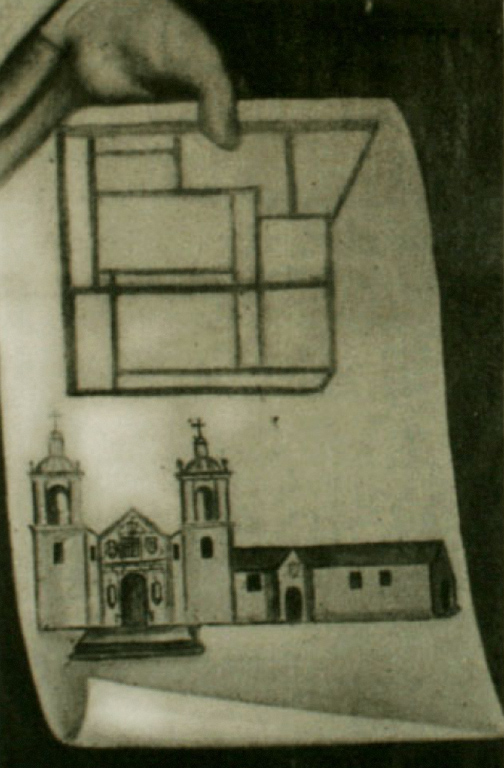
Croquis de la antigua Iglesia de la Merced de acuerdo al retrato de su fundador. In: Pereira, Eugenio. 1965. Historia del Arte en el Reino de Chile. Ediciones de la Universidad de Chile. Santiago, Chile.
According to writs, the Mercedarios is the oldest congregation in Chile, since they arrived with Don Pedro de Valdivia from the Viceroyalty of Peru. Due to this and showing his appreciation, the conquistador donated the Chapel del Socorro. When it was initially built, the Church of la Merced was established next to the chapel, where the Church of San Francisco now stands.
The Mercedarios went to the Conquest of the Araucanía along with Valdivia, but Padre Antonio Correa remained in the chapel, and even established a hospice, but when he died and after the chapel was abandoned for several years, the Franciscans take possession of the land, calling on the generous donation made by Governor Rodrigo de Quiroga.
Approximately a year and a half later, the Mercedarios came back and to their surprise they discovered that their land had been taken and promptly demanded that the Franciscans return their land to them immediately, however, the Franciscans refused to do so and called on the decision of the Royal Audience of Lima in 1556, which responded in favor of the Franciscans.
Stripped from their lands, Juan Fernández de Alderete donates some homesteads to the Mercedarios that comprised the land between the current Miraflores, Huérfanos, and Merced Streets and the back part of the Santa Lucía Hill, the same lands occupied by the Franciscans when they arrived to Chile and that they had abandoned due to the constant floods produced by the increase of the Mapocho River water level.
There, they founded the Convent of Saint Joseph and took possession of the church that had been built by Don Rodrigo de Quiroga, in 1562. The Cabildo, in order to compensate the transfer of the Chapel del Socorro to the Franciscans, handed over the Chapel of Santa Lucía to them.
A second temple of very large proportions started to be built, but just when it was about to be finished it suffered several damages in the 1647 earthquake and later in the 1730 one, when its floor sank. In 1735, a third temple was built, the one still found in the current location and it is said that the architect Joquín Toesca also participated in its building, along with other construction works in Santiago that also had his intervention.
The land of Merced that reached to the skirts of the Santa Lucía Hill got lost with the growth of the city, and the crop gardens and orchards they owned in that same location disappeared.
In 1966, it was awarded the title of Basilica by the Archbishop of Santiago, Cardinal Raúl Silva Enríquez.
The importance of this temple for the city can be measured by the re-known people buried there. The human remains of Doña Inés de Suárez rest in the Cathedral. She was the first woman to come to Chile with the armies of Don Pedro de Valdivia, and the wife of Rodrigo de Quiroga, who is also buried in this Basilica, as well as Governor Gill y Gonzaga, promoter of the construction of the Calicanto Bridge and Don Mateo de Toro y Zambrano, President of the first National Government Junta.